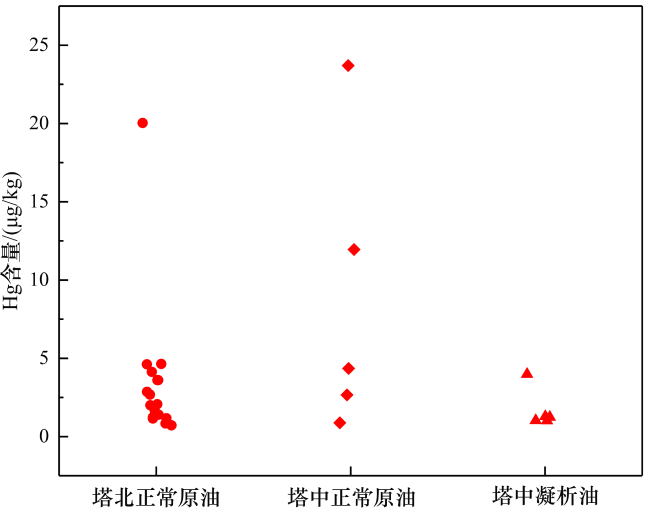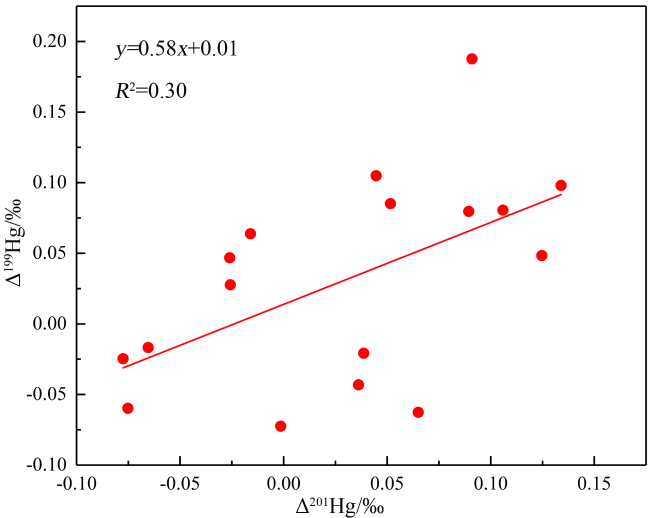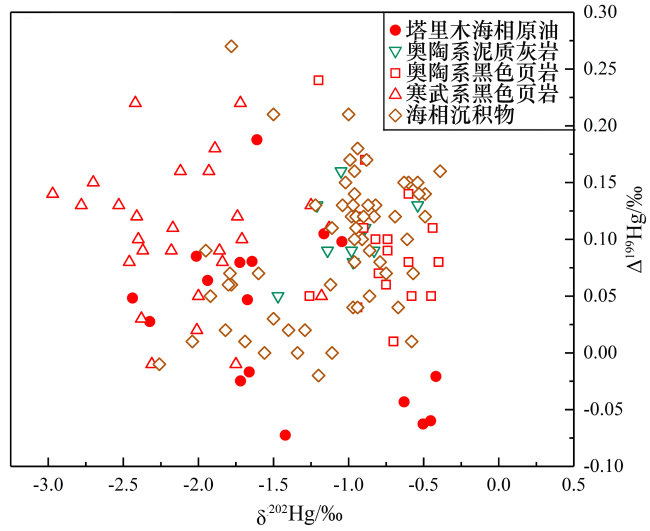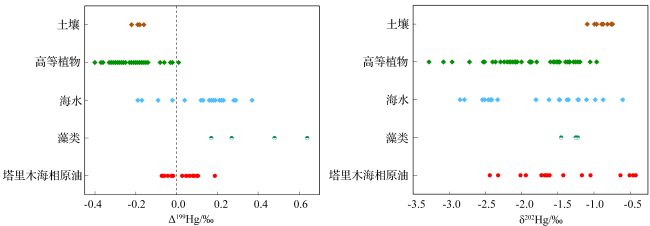0 引言
1 样品采集与分析
1.1 研究区域与样品采集
1.2 原油样品预处理
1.3 汞含量分析
1.4 汞同位素分析
2 结果与讨论
2.1 原油中汞含量
表1 塔里木盆地海相原油的汞含量及汞同位素组成Table 1 Mercury content and mercury isotope composition of marine crude oil in Tarim Basin |
| 地区 | 区块 | 井号 | 深度/m | Hg/(ng/g) | δ199Hg/‰ | δ200Hg/‰ | δ201Hg/‰ | δ202Hg/‰ | Δ199Hg/‰ | Δ200Hg/‰ | Δ201Hg/‰ | 密度(20 ℃) /( g/cm3) | 密度(50 ℃) /( g/cm3) | 黏度/(mm2/s) | 含硫量/% |
|---|---|---|---|---|---|---|---|---|---|---|---|---|---|---|---|
| 塔北正常原油 | 富源 | FY103-1x | 7 425.94 | 3.60 | -0.19 | -0.53 | -0.83 | -1.16 | 0.10 | 0.05 | 0.04 | 0.80 | 0.78 | 1.58 | 0.18 |
| 塔北正常原油 | 富源 | FY201-2x | 7 117 | 1.40 | 0.83 | 0.81 | 4.39 | 0.25 | |||||||
| 塔北正常原油 | 富源 | FY202 | 7 530 | 4.13 | 0.83 | 0.81 | 3.30 | 0.19 | |||||||
| 塔北正常原油 | 富源 | FY204 | 7 329 | 1.15 | |||||||||||
| 塔北正常原油 | 富源 | FY101 | 7 415 | 2.68 | -0.46 | -0.79 | -1.37 | -1.72 | -0.02 | 0.07 | -0.08 | 0.85 | 0.83 | 4.34 | 0.47 |
| 塔北正常原油 | 富源 | FY208 | 7 432 | 1.71 | 0.82 | 0.79 | 1.99 | 0.15 | |||||||
| 塔北正常原油 | 哈9 | HA9-4 | 4.61 | -0.17 | -0.23 | -0.42 | -0.45 | -0.06 | 0.00 | -0.08 | 0.82 | 0.80 | 2.94 | 0.15 | |
| 塔北正常原油 | 哈得 | HD25-1 | 6 529 | 1.23 | -0.33 | -0.76 | -1.13 | -1.64 | 0.08 | 0.07 | 0.11 | 0.82 | 0.79 | 2.60 | 0.14 |
| 塔北正常原油 | 金跃 | JY6 | 6 942 | 2.86 | 0.82 | 0.80 | 2.23 | 0.28 | |||||||
| 塔北正常原油 | 轮南 | LN57 | 5 002 | 1.16 | 0.80 | 0.78 | 2.01 | 0.13 | |||||||
| 塔北正常原油 | 热普 | RP301 | 7 069 | 1.60 | 0.80 | 0.78 | 1.48 | 0.15 | |||||||
| 塔北正常原油 | 热普 | RP3013 | 7 135 | 4.64 | |||||||||||
| 塔北正常原油 | 英买 | YM-10 | 7 256 | 2.07 | -0.42 | -0.91 | -1.47 | -1.94 | 0.06 | 0.07 | -0.02 | 0.80 | 0.78 | 1.95 | 0.13 |
| 塔北正常原油 | 英买 | YM1-1(1) | 7 289 | 0.83 | -0.13 | -0.19 | -0.28 | -0.42 | -0.02 | 0.02 | 0.04 | 0.82 | 0.80 | 2.65 | 0.11 |
| 塔北正常原油 | 英买 | YM2-4(2-2) | 7 246 | 2.00 | -0.35 | -0.83 | -1.21 | -1.72 | 0.08 | 0.04 | 0.09 | 0.82 | 0.80 | 2.87 | 0.18 |
| 塔北正常原油 | 英买 | YM3-5C | 20.03 | -0.44 | -0.80 | -1.31 | -1.66 | -0.02 | 0.03 | -0.07 | 0.76 | 0.74 | 0.94 | 0.13 | |
| 塔北正常原油 | 英买 | YM5-3 | 7 292 | 0.71 | -0.37 | -0.74 | -1.28 | -1.67 | 0.05 | 0.10 | -0.03 | ||||
| 塔北正常原油 | 英买 | YM701 | 7 334 | 3.60 | -0.22 | -0.79 | -1.12 | -1.61 | 0.19 | 0.02 | 0.09 | 0.90 | |||
| 塔中正常原油 | 中古 | ZG61 | 3 738 | 0.88 | -0.56 | -1.13 | -1.77 | -2.32 | 0.03 | 0.04 | -0.03 | 0.83 | 0.81 | 2.61 | |
| 塔中正常原油 | 中古 | ZG26-H8 | 4.35 | -0.42 | -0.92 | -1.46 | -2.01 | 0.09 | 0.09 | 0.05 | |||||
| 塔中正常原油 | 中古 | ZG-291-H | 6 192 | 11.94 | -0.19 | -0.18 | -0.31 | -0.50 | -0.06 | 0.07 | 0.07 | 0.80 | 0.78 | 1.72 | 0.19 |
| 塔中正常原油 | 中古 | ZG-434 | 6 301 | 23.70 | -0.17 | -0.45 | -0.65 | -1.04 | 0.10 | 0.07 | 0.13 | 0.85 | 0.83 | 5.72 | 0.38 |
| 塔中正常原油 | 中古 | ZG15-H4 | 6 143 | 2.67 | 0.80 | 0.77 | 1.75 | 0.17 | |||||||
| 塔中凝析油 | 中古 | ZG14-1 | 6 298 | 1.29 | 0.79 | 0.77 | 1.67 | 0.19 | |||||||
| 塔中凝析油 | 中古 | ZG46 | 5 367.34 | 1.02 | 0.78 | 0.76 | 0.83 | 0.16 | |||||||
| 塔中凝析油 | 中古 | ZG16-3X | 1.24 | -0.43 | -0.63 | -1.07 | -1.42 | -0.07 | 0.08 | 0.00 | |||||
| 塔中凝析油 | 中古 | ZG172 | 6 210 | 3.98 | -0.20 | -0.39 | -0.44 | -0.63 | -0.04 | -0.07 | 0.04 | 0.81 | 0.79 | 2.44 | 0.28 |
| 塔中凝析油 | 中古 | ZG22 | 5 736.7 | 1.03 | -0.57 | -1.17 | -1.71 | -2.44 | 0.05 | 0.05 | 0.12 | 0.78 | 0.76 | 1.16 | 0.11 |
表2 海相原油中汞含量的t检验Table 2 The t-test analysis of mercury content in marine crude oil |
| t检验内容 | 汞含量/(μg/kg) | 1SD | P值 | n | |
|---|---|---|---|---|---|
| 油种类 | 正常原油 | 4.50 | 5.99 | 23 | |
| 凝析油 | 1.71 | 1.28 | 5 | ||
| 正常原油与凝析油 | 4.00 | 5.53 | 0.32 | 28 | |
| 地点 | 塔北 | 3.33 | 4.36 | 18 | |
| 塔中 | 8.71 | 9.38 | 5 | ||
| 塔北与塔中原油 | 4.50 | 5.99 | 0.28 | 23 | |
2.2 原油中汞同位素组成特征
表3 原油样品中汞同位素质量分馏和非质量分馏信息统计Table 3 Mass dependent and mass independent fraction of mercury isotope in crude oil samples |
| 汞同位素 | 样品 | 均值/‰ | 1SD | 最小值/‰ | 最大值/‰ | 样品数 |
|---|---|---|---|---|---|---|
| δ202Hg | 整体 | -1.43 | 0.64 | -2.44 | -0.42 | 17 |
| 塔北正常原油 | -1.40 | 0.54 | -1.94 | -0.42 | 10 | |
| 塔中正常原油 | -1.47 | 0.84 | -2.32 | -0.50 | 4 | |
| 塔中凝析油 | -1.50 | 0.91 | -2.44 | -0.63 | 3 | |
| Δ199Hg | 整体 | 0.03 | 0.07 | -0.07 | 0.19 | 17 |
| 塔北正常原油 | 0.04 | 0.08 | -0.06 | 0.19 | 10 | |
| 塔中正常原油 | 0.04 | 0.07 | -0.06 | 0.10 | 4 | |
| 塔中凝析油 | -0.02 | 0.06 | -0.07 | 0.05 | 3 |







 甘公网安备 62010202000678号
甘公网安备 62010202000678号